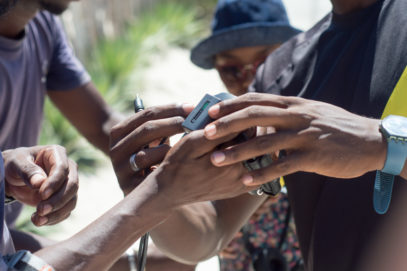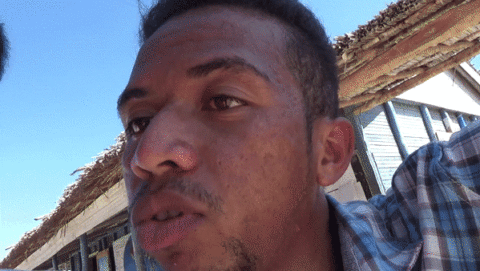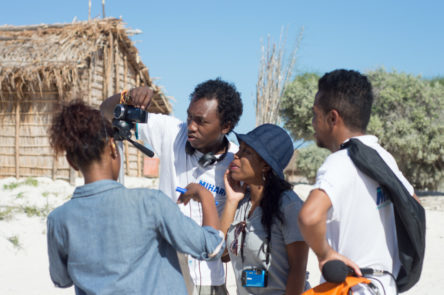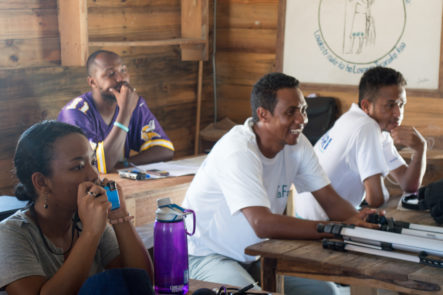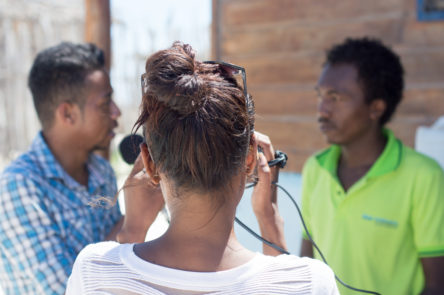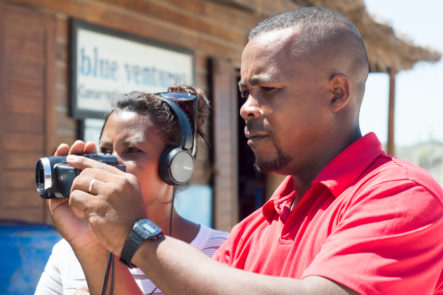“We have a specialist coming from the UK…”
“What? You mean Matt!?”
Hearing the retelling of this conversation brought a smile to my face. Let me set the scene. My old friend and colleague Valerie and I are sharing a beer and stories at the end of an intense week of ‘Participatory Video’ training in southwest Madagascar. Valerie’s recounting – with laughter in her eyes – how her old university mate, who had dabbled with making video on York Student TV, was now being referred to as a video *specialist* – a surprising development for both of us!
It’s been thirteen days since I arrived in the coastal village of Andavadoaka, the bustling hub of Blue Ventures in Madagascar. My aim? To deliver a workshop that would dive into the essential and practical skills required to run ‘Participatory Video’ projects, and to get my Blue Ventures colleagues thinking about how they might use this powerful tool with the communities they work with.
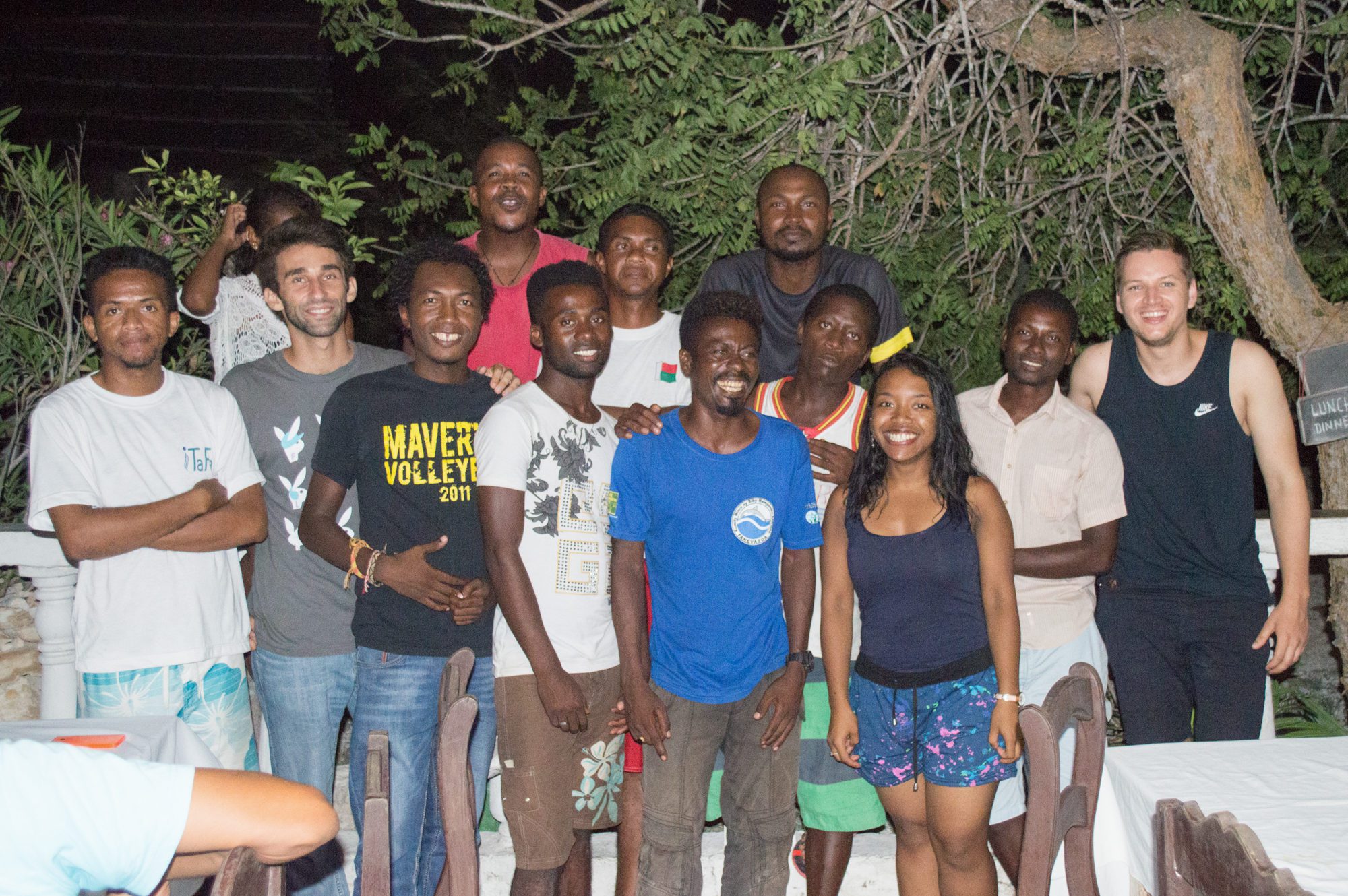
The Participatory Video group, with Matt on the far right.
Participatory Video: the basics
In a nutshell, ‘Participatory Video’ refers to any process that gives individuals and groups the tools and skills they need to come together and produce a film, granting them ownership of both the film design and the physical production. For coastal communities in Madagascar, this ownership enables them to produce a more authentic glance into their lives and experiences, as well as limiting the chance of them being misrepresented.
With that as our goal, twelve of my Madagascar-based colleagues and I spent five days working through a series of practical and reflective activities designed to quickly teach critical camera handling and filmmaking skills. We were equipped with a handful of low-cost camcorders, microphones and tripods that I had brought from Bristol, and that had thankfully made it through customs relatively unhandled.
You can imagine how much fun (and how funny to watch) it was getting everyone to take turns operating the cameras and recording short videos on our first day. To start with, I handed over a camcorder to the group, asking each of them to turn it on and record a short clip of themselves. This is a simple task for those familiar with cameras and filmmaking, but the majority of my trainees had not seen this type of camera before, and some had never been exposed to video cameras at all. Everyone spent a nervous few moments pulling and pushing on the various things that could be pushed and pulled and tentatively pressing buttons, but sooner or later, and with the enthusiastic support of their peers, everyone managed to grasp the basic functions of the camera and record a short video introducing themselves to the group.
A Steep Learning Curve
By choosing to throw my trainees straight into the deep end like this, and setting a series of unexpected challenges throughout the week (such as “you have 10 minutes to go and make a video presentation on an object in your environment”), they all quickly learned what worked and what didn’t, absorbing critical new skills with each task. Almost everyone who picks up a camera learns by doing, and Participatory Video training delivered in this manner just condenses this learning experience into a few days. Throughout the training, mistakes were not really mistakes but rather opportunities to learn before trying again in the next activity!
After each training activity we would review the footage as a group, our discussions often interrupted by bouts of raucous laughter usually because someone had inadvertently zoomed in on something inappropriate. These reviews were also an opportunity for the group to reflect on how they might best deliver the same training activity to the communities they work with every day.
We also explored a series of tools that can help filmmakers identify and examine crucial issues, and think about how they could be presented in video. Tools like this are where participatory video has the potential to add real value. By understanding how you can present an idea on film for an audience other than yourself, and by breaking down the complexities of that issue so it can be communicated clearly, you can gain a greater understanding of the issue itself. These tools can help communities to explore new perspectives, identify pathways for solving problems and work towards a consensus on important issues.
One of the activities I introduced was called ‘River of Life,’ a visual exercise where participants draw their lives or specific experiences as a flowing river. In this river, the causes of significant moments are drawn as tributaries and the effects of these moments as streams branching out from the main river. By identifying and visualising key moments in this way, you can better understand the complexities of a story or an idea, and then decide which elements would need to be presented in a film to make the story clear to the audience.
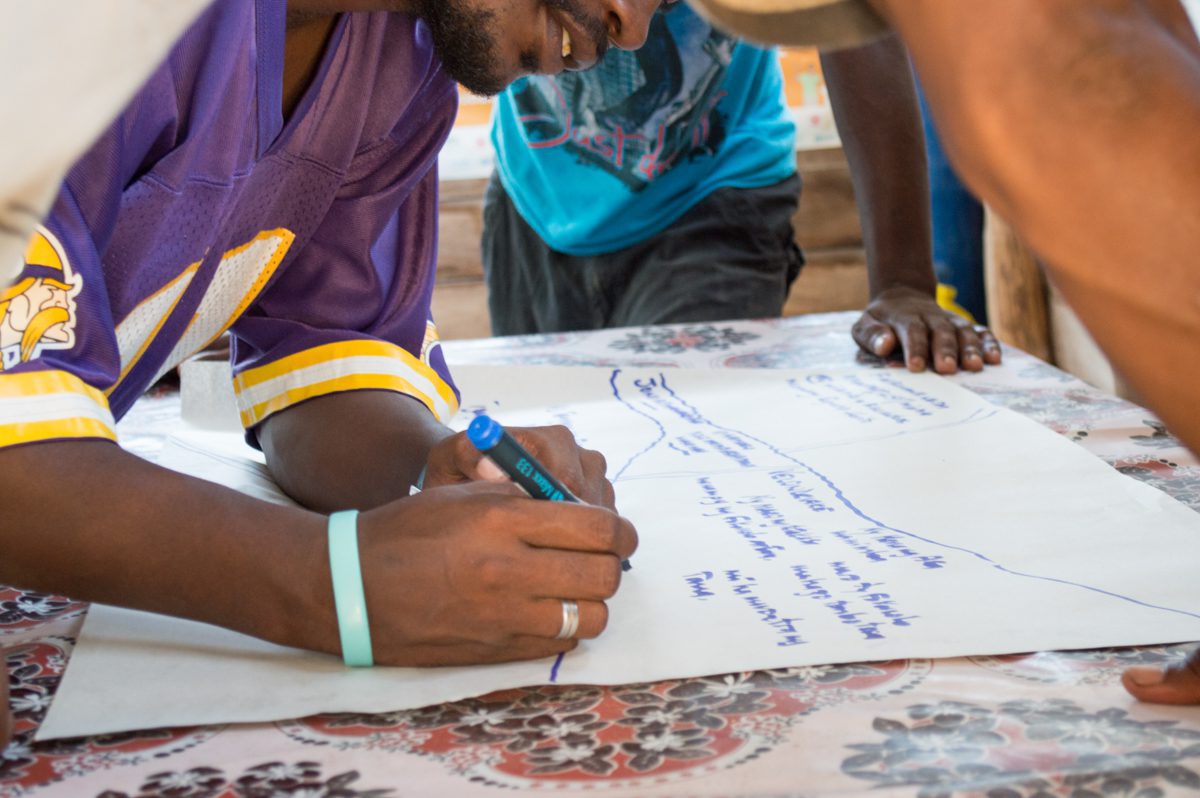
The River of Life
After just a few days of these activities, I knew my trainees were ready to use the technical and reflective skills they had learned to identify stories and make their own films. The group was split, and three short films were successfully produced and edited: one on Blue Ventures’ Scholarship Programme, one on the importance of preserving mangrove forests, and one about drinking clean and safe water (note: these films are in Malagasy!)
Considering the inexperience of the group at the beginning of the training, the progress everyone had made was very impressive! After the final day with the group, I wrote in my journal:
“It was so cool to watch the trainees planning their own film, everyone taking the time to design the story, think through how they wanted to present ideas, and really considering what they were going out to film.”
This careful consideration is so important. What are the factors that really influence your film subject? Who needs to speak to make your film credible? What film ingredients (drama, comedy, interview etc.) would make the message of your film clear? Planning production in this way is a vital component of effectively using film to communicate ideas.
Ultimately empowering
Film, as a tool for communication is something most in the UK are intimately familiar with. From advertisements, to vlogs to the latest hollywood blockbusters, we are used to seeing complex ideas, themes and issues explored on screen, and for many the ability to tap into film as a medium to share ideas is part of their daily existence. We have smartphones, we have camcorders and good internet – and if we want, we can share our stories with the world with relative ease.
In remote low-income communities there is simply no ready access to the technology or training that we take for granted, and filmmaking is a challenge that participatory video is designed to make achievable. My training workshop has proved to me that it is possible to equip an inexperienced group with the technology, skills and processes required to create a film, and have them achieve that in just a few short days.
Now my colleagues can take the activities and lessons-learned from this workshop into the communities they work with, empowering more people with access to a new, powerful means of communication.
Participatory video has the potential to help groups of people better understand each other’s stories, successes and challenges, and tell these stories in a way that can reach the world, and I’m excited that Blue Ventures is investing in this new way of empowering coastal communities, both in Madagascar and beyond.
Discover how participatory video can be used to promote sustainable fishing practices in one of our most popular blogs: What does kung fu have to do with octopus fishing?


